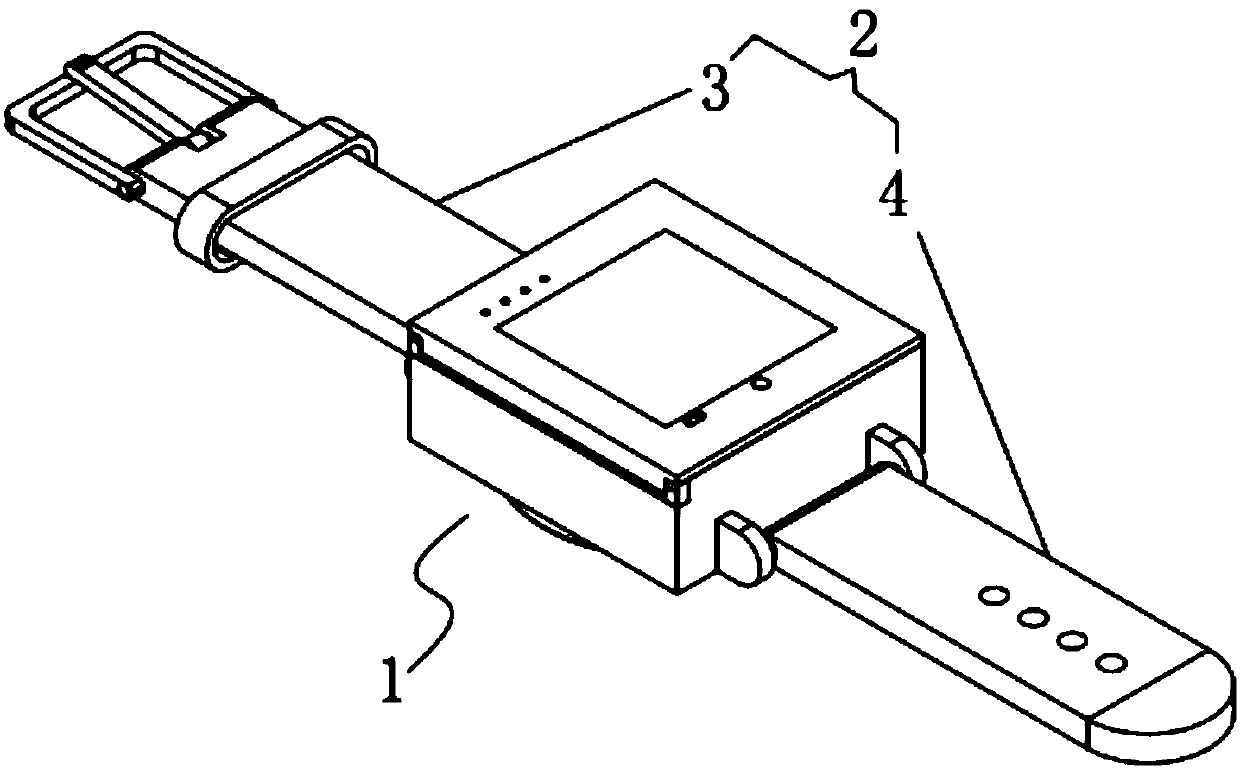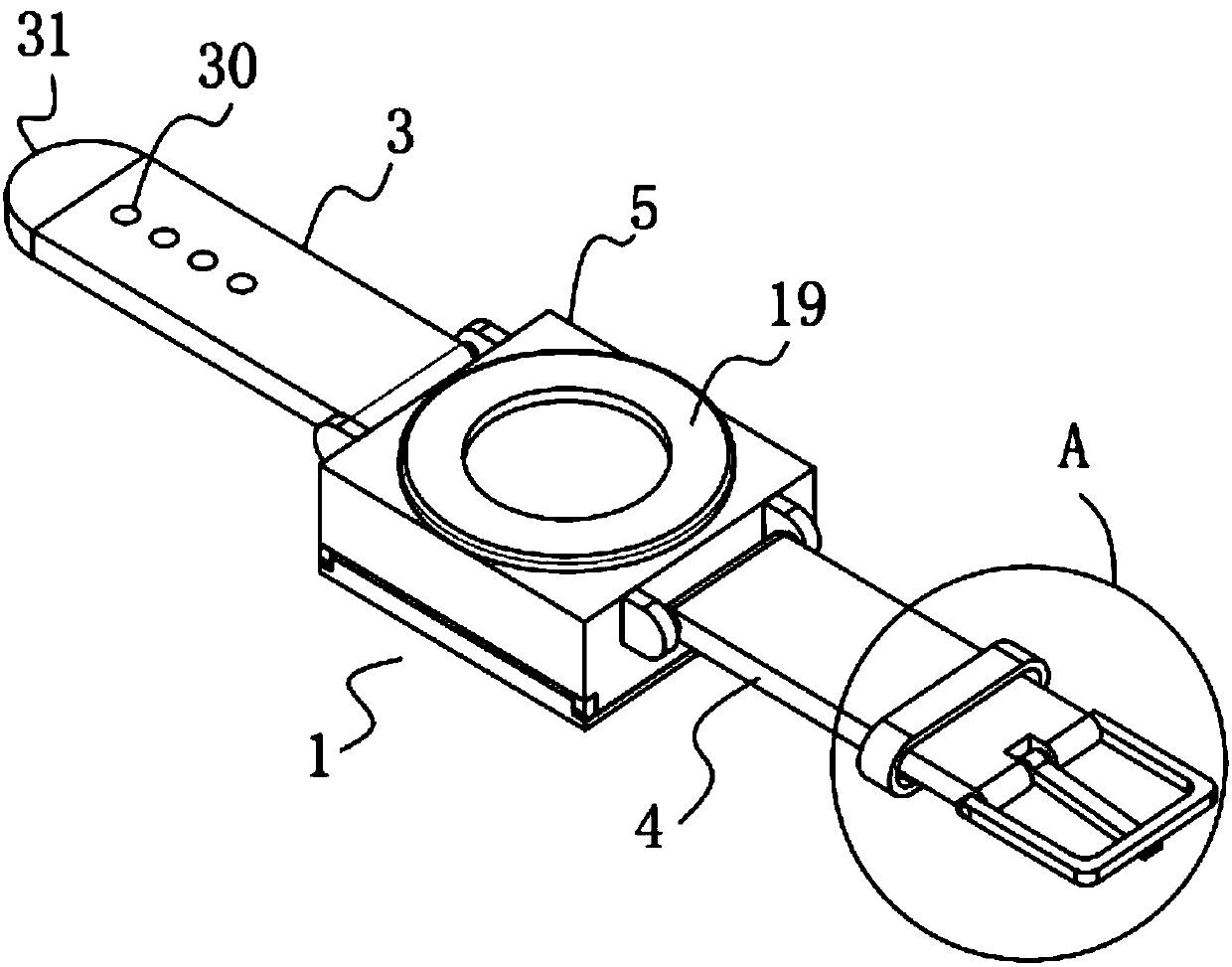Fall-down detector
A technology of detectors and detection parts, applied in diagnostic recording/measurement, sensors, diagnosis, etc., can solve problems such as fainted people can't tell, and achieve the effect of ensuring life safety
- Summary
- Abstract
- Description
- Claims
- Application Information
AI Technical Summary
Problems solved by technology
Method used
Image
Examples
Embodiment 1
[0059] A fall detector such as figure 1 , 4 , 5, 6, 7 and 15, including the detection part 1, the detection part 1 includes the shell 5 and the upper cover 6 and the installation box 10, the rear edge of the upper cover 6 and the rear part of the shell 5 The upper edge is hingedly connected, and the installation box 10 is fixedly installed on the bottom of the upper cover 6 near its rear edge, and the inside of the installation box 10 is fixedly installed with a battery 20, a processor 21, and an acceleration sensor 22 And the gyro sensor 23 and the buzzer 24, the inside of the upper cover 6 is embedded with a touch display 8 in the center, the battery 20 is connected in series with the processor 21 through wires, and the touch display 8 is bidirectionally electrically connected to the processor 21 through a data line, and the signal output ends of the acceleration sensor 22 and the gyro sensor 23 are electrically connected to the signal input end of the processor 21 through ...
Embodiment 2
[0080] The difference from Example 1 is that the surface of the casing 5 and the surface of the upper cover 6 are provided with a protective layer, and the protective layer is prepared by the following method:
[0081] Take the following raw materials and weigh them by weight: 20 parts of epoxy resin, 8 parts of calcium carbonate powder, 10 parts of copper oxide powder, 15 parts of aluminum silicate, 8 parts of quartz powder, 13 parts of polyurethane, 3 parts of silane coupling agent, alcohol 2 parts of ester twelve parts, 2 parts of triethanolamine, 1 part of emulsified silicone oil and 30 parts of water;
[0082] S1. Add the weighed silane coupling agent, alcohol ester dodecane, triethanolamine, emulsified silicone oil and water into the mixer and stir for 15 minutes at a stirring speed of 500r / min to prepare a mixed solution;
[0083] S2, adding epoxy resin, calcium carbonate powder, copper oxide powder, aluminum silicate, quartz powder and polyurethane into a pulverizer fo...
Embodiment 3
[0089] The difference with embodiment 2 is the preparation of protective layer, and its specific preparation method is as follows:
[0090] Take the following raw materials and weigh them by weight: 24 parts of epoxy resin, 9 parts of calcium carbonate powder, 11 parts of copper oxide powder, 18 parts of aluminum silicate, 9 parts of quartz powder, 14 parts of polyurethane, 4 parts of silane coupling agent, alcohol 3 parts of ester twelve, 3 parts of triethanolamine, 2 parts of emulsified silicone oil and 40 parts of water;
[0091] S1. Add the weighed silane coupling agent, alcohol ester dodecane, triethanolamine, emulsified silicone oil and water into the mixer and stir for 18 minutes at a stirring speed of 600r / min to prepare a mixed solution;
[0092] S2, adding epoxy resin, calcium carbonate powder, copper oxide powder, aluminum silicate, quartz powder and polyurethane into a pulverizer for pulverization until the particle diameter of the material is not greater than 100n...
PUM
 Login to View More
Login to View More Abstract
Description
Claims
Application Information
 Login to View More
Login to View More - R&D
- Intellectual Property
- Life Sciences
- Materials
- Tech Scout
- Unparalleled Data Quality
- Higher Quality Content
- 60% Fewer Hallucinations
Browse by: Latest US Patents, China's latest patents, Technical Efficacy Thesaurus, Application Domain, Technology Topic, Popular Technical Reports.
© 2025 PatSnap. All rights reserved.Legal|Privacy policy|Modern Slavery Act Transparency Statement|Sitemap|About US| Contact US: help@patsnap.com



